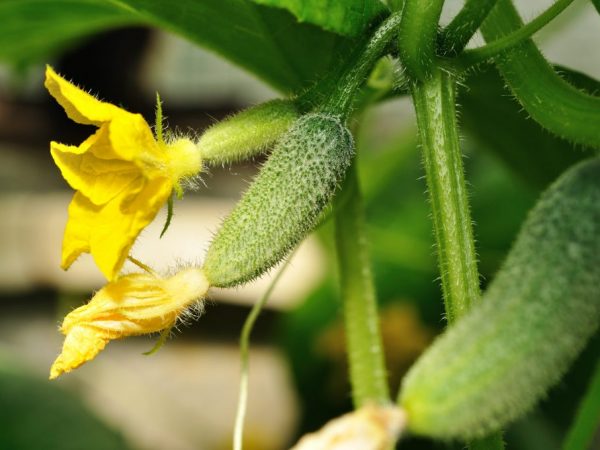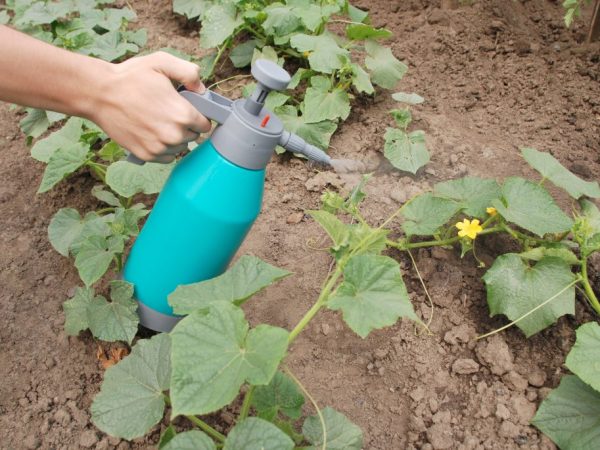Rules for feeding cucumbers with ammonia
Salmon is known as a first aid for fainting, as well as a substance that is used in everyday life for cleaning glass, dishes, jewelry, removing stains. Ammonia is indispensable in the care of house plants. With its help, you can get rid of, for example, midges that can harm young, only transplanted plants. Feeding cucumbers with ammonia will provide an ambulance with a nitrogen deficiency.

Rules for feeding cucumbers with ammonia
Fertilizer characteristic
Ammonia is an aqueous solution of ammonia (ammonium hydroxide). In everyday life, it is mistakenly called ammonia. In fact, ammonia is a completely different chemical, ammonium chloride (ammonium salt of hydrochloric acid, ammonium chloride).
Ammonia is a colorless volatile liquid with a pungent odor. The substance is alkaline. For medical purposes, a 10% solution is usually used.
Benefit
The value of the drug is determined by the fact that:
- the nitrogen content in it (by weight of the substance) is 41%;
- when feeding with ammonia, there is no oversaturation of plants with nitrogen, nitrates harmful to humans do not accumulate;
- ammonia is one of the stages of the natural nitrogen cycle, therefore, for garden crops, the use of ammonia may be more effective than for fertilizers available to plants with the participation of microorganisms.
The drug has a medium alkaline reaction. Using it, the gardener does not risk acidifying the soil (beneficial microorganisms suffer from this, and as a result, crops).
Application
All vegetable crops respond well to fertilization with ammonia: onions, garlic, tomatoes, bell peppers. Watering flowers with ammonia is effective, especially bulbs, as well as nasturtiums, dahlias, roses, clematis, and zinnias.

You can use top dressing not only for cucumbers
Watering with this fertilizer is also carried out in berry fields. However, the beloved strawberry poorly assimilates nitrogen from this compound, the treatment is indicated to combat its main pests: slugs, ants. If you treat the garden with such a composition, you can prevent damage to the fruit by wasps and ants.
Precautions
Pure ammonia has a toxic effect on the body, penetrating through the respiratory tract, mucous membrane, skin. If it comes into contact with the skin and mucous tissues, an aqueous solution of ammonia of high concentration can cause a burn, therefore, when preparing working solutions for fertilizing and treating plants, during the procedures, safety rules must be observed:
- use personal protective equipment: rubberized gloves, respiratory protection (respirator), glasses;
- located upwind when spraying;
- when processing plants in greenhouses, you should open the frames, raise the canopy; spray indoor flowers on the balcony by an open window.
If the substance comes into contact with the skin, it is washed with plenty of water.At the first signs of poisoning (nausea, vomiting), it is recommended to drink milk, seek help from a medical institution.
Avoid getting the solution on the wiring, decorative coatings, because this can cause damage to the winding, cracking.
Feeding methods
There are only 2 feeding methods:
- root;
- foliar.

Nitrogen starvation can be eliminated by spraying
Under the root
Watering cucumbers with ammonia is carried out to meet the nitrogen demand of cucumbers. This is an element that is a "building brick" of all living things, necessary for participants in metabolic processes. Its abundance is especially important during the growth stage, when the green mass increases.
The fact that cucumbers need nitrogen feeding can be recognized by the following signs:
- yellowing of leaves, unnatural reduction in size;
- thinning and fragility of the stem;
- stunting.
It is recommended to fertilize cucumbers with an ammonia solution after the appearance of 4-5 true leaves, when the bush begins to branch. A solution is prepared for watering: 3 tbsp. l. substances on a bucket of water. Watering with such a composition is necessary at the root. The frequency depends on the state of the culture. If the lashes grow slowly, there is a lot of barren flowers, the cucumbers do not fit, the feeding is repeated with the addition of phosphorus fertilizers.
You can also water cucumber seedlings (or young plants when grown in a seedless way). An obligatory rule is to pour from a watering can without a spray with a weak stream at the root. To prevent burns, you can spray on the leaves with clean water.
Foliar dressing
For the emergency elimination of nitrogen starvation, you can carry out foliar feeding of cucumbers with ammonia. The working solution for this is prepared at the rate of 50 ml of 10% ammonium hydroxide per 10 liters of water. Foliar dressing is carried out using a watering can, and not a spray bottle.
The substance used is unstable; when sprayed, most of the useful component can evaporate without bringing any benefit to the vegetable crop. The general rule is to carry out the action in calm weather after sunset or in the morning on a cloudy day.
Pest control
Every year the cucumber beds suffer from aphids. It settles on the inner side of the leaf, sucks out useful substances, which leads to curling and drying of the leaves, the fall of the ovary. Treatment of cucumbers with a solution of ammonia can help in the fight against the pest.
For this purpose, a sufficiently concentrated solution is prepared: in 50 ml of ammonia solution, 100-200 g of grated laundry or baby soap is added to a bucket of water (for the liquid to stick to the leaves). According to gardeners, a single treatment is enough, but if it was not possible to completely destroy the pest, you can repeat the procedure after 2 weeks.
Conclusion
At first glance, the concepts of "cucumbers" and "ammonia" exclude each other, but the practice of gardeners has confirmed the effectiveness of using this substance not only as a fertilizer (it can be watered and sprayed), but also as a means of combating vegetable pests.
Pharmacy ammonia solution is inexpensive. There is no difficulty in preparing working solutions. With the help of the substance, you can provide ambulance to vegetables and garden crops, so that a vial of ammonia should be stored in a cool, dark place for every gardener.


